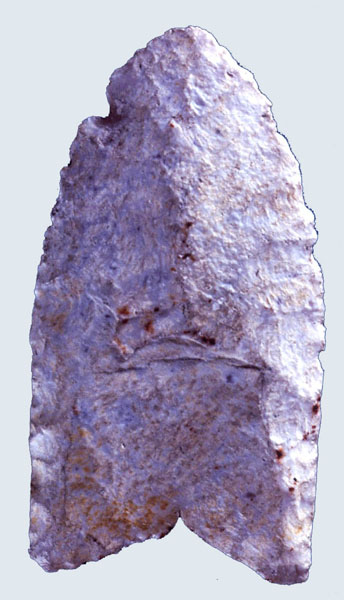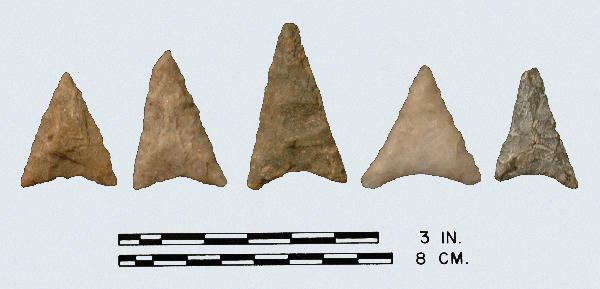
Ft. Nottoway: quartzite, quartzite preform, rhyolite retouched.

Ft. Nottoway: William Allgood Collection; Top Row: all quartzite; Bottom Row: rhyolite, quartzite, quartzite.

Big Sandy: Top Row: rhyolite, chert, chert; Bottom Row: chert, mylonite, chert.

Kessell: Both chert
Type Side Notched Early-Archaic
Defining Attributes
The Fort Nottoway is a medium to large, square base, side notched point with beveled and serrated edges.
Chronology
The Fort Nottoway point dates to the Early Archaic period, 7000 to 6700 BCE. McAvoy obtained radiocarbon dates of 6970 +/- 65 and 6850 +/-120 BCE from the Cactus Hill Site (44SX0202) for this type
Description
- Blade: The original preforms are slightly pentagonal in shape. The original blade from the preform was large, excurvate without bevel or serrations. Serrations are small and associated with the beveling flakes, creating an incurvate blade. These points are almost always resharpened with alternate edge beveling.
- Base: The side notches, parallel to the base, are narrow and deep on most examples. Points slope slightly inward at the basal corner, reflecting the pentagonal shape of the preform. The base is usually slightly concave but may be straight. Both the base and notches are heavily ground. The base may be thinned by one or two long flakes up the blade face.
- Size: Length ranges from 45 to 100 mm. The width ranges from 25 to 50 mm. Thickness ranges from 4 to 8 mm, which is unusually thin for the length and width of the point.
- Technique of manufacture: Soft percussion was the flaking technique, finished with pressure retouch along the edge and notch.
Discussion
The Fort Nottoway point is similar to the early Big Sandy point as described by Lewis and Lewis (1961) at the Eva Site in Tennessee. The Kessell Side Notched point, reported by Broyles (1971) at the St. Albans Site, West Virginia is also similar. However, the Kessell point at the St. Albans Site was dated at 7900 BCE, a thousand years earlier than the Fort Nottoway point. Gardner (1988) described a similar side-notched point that he defined as Warren. A date of 7300 BCE was obtained at the Thunderbird Complex in Warren County, Virginia from a zone separating earlier corner-notched from later Warren side notched points.
Defined in Literature
McAvoy defined the Fort Nottoway point from examples found along the Nottoway River, Virginia.
References




